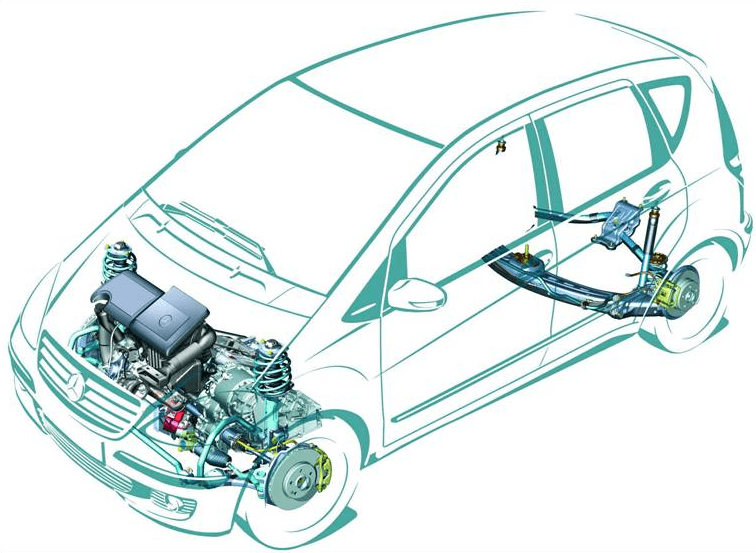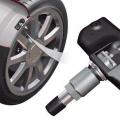If the task of the motor is to create torque, then the transmission has a role in transferring it to the drive wheels. Depending on which of them - front or rear - are connected by means of a transmission to the engine, the car is considered front-wheel drive or rear-wheel drive. In this article, you will learn how rear-wheel drive differs from front-wheel drive and what are the advantages and disadvantages of both of these schemes.
Rear-wheel drive: history and features
The first cars were produced on a rear-wheel drive scheme. This is due to the simpler location of the engine, gearbox, rear axle gearbox along the longitudinal line of the car body. The flexibility of the connection is ensured by the cardan shaft.
The rear axle, in the casing of which there are two axle shafts with wheels, is located at right angles to the cardan axis. For this arrangement, a full-size gearbox had to be created. The complexity of its structure lies in the independence of the two rear wheels: when turning, the inner moves faster than the outer.
It is quite simple to see the operation of the gearbox: it is enough to raise one of the rear wheels with a jack, start the engine and engage the gear (placing shoes under the front wheels). A wheel standing on the asphalt will be motionless, and a wheel hanging in the air will start spinning. This is the work of the differential, which distributes the torque between the axle shafts of the rear axle.
Front-wheel drive: device and reasons for its popularity
The principle of transferring the rotation of the motor, the gearbox shaft to the wheels is similar to the rear-wheel drive: a gearbox with a differential and propeller shafts are required. The difference lies in the constructive solution of these components and assemblies.

The front wheels, being the leading ones, demanded a closer placement of the checkpoint to themselves. This made it possible to position the engine-gearbox bundle on the same centerline with the wheels in the front engine compartment. The transverse placement of the motor led the engineers to create a more compact engine and gearbox while maintaining their power. Therefore, despite the appearance of the first prototype of a front-wheel drive car at the beginning of the 20th century, they began to be mass-produced only in the second half of the last century.
If the gearbox, the gearbox in such an arrangement are structurally similar to the rear-wheel drive, then the cardans have a significant difference. In the front-wheel drive scheme, CV joints are involved, or ball gearboxes of angular speeds. If the universal joint has two degrees of freedom, then the CV joints connect the two axle shafts more smoothly. The angle of such a joint reaches 70 ° without serious, in contrast to the universal joint, wear of rubbing parts. Also CV joints allow you to change the angle of rotation of the wheels - to control the car.
Comparison of two types of drive: their advantages and disadvantages
Despite the differences in the details of the layout, the front-wheel drive is created with the placement of the motor in the area of the front wheels. The rear-wheel drive scheme is more flexible in this regard and allows the motor to be anywhere. There are front-engined, mid-engined (in front of the driving wheels) and rear-engined configurations. To understand how rear-wheel drive differs from front-wheel drive in practice, it is necessary to compare their strengths and weaknesses.

Pros of rear driving wheels
- Rear-wheel drive allows for high maneuverability of the machine due to less restriction on the steering angles of the front wheels.
- Good stability on the ground: the drive pair works on the track already laid by the front pair.
- An elongated bundle (motor, steered front wheels and driving rear) allows you to more smoothly control the machine when skidding - uncontrolled drift of the driving pair from the canvas.
- When starting from a standstill, the mass of the body is transferred backward, increasing the adhesion of the tires to the road.
disadvantages
- Rear-wheel drive is more prone to skidding.
- Such a scheme requires a larger working volume, not allowing the body to be minimized.
Front-wheel drive problems
- The concentrated mass in the front of the engine compartment (engine, gearbox, gearbox, axle shafts, CV joints) excludes proportional weight distribution over the body.
- Acceleration from standstill often occurs with slippage due to the transfer of body weight to the rear.
- When skidding, it is more difficult to keep the car on the road due to the combination of the steering and drive functions in the front wheels.
Advantages
- This arrangement makes the car more passable on wet ground: it drags the car, as if in tow, and does not push all the weight in front of it, as with rear-wheel drive.
- The front-wheel drive gives the car less weight, compactness of the arrangement of the units, which makes it easy to modify the body in two and even one-volume variants of the layout.
- The inseparable combination of control of the machine both in speed and direction, allows you to better "feel" the steering wheel.
Modern technology compensates for many of the difficulties of front and rear drives, so the choice often depends on the personal taste of the user, and not on the capabilities of the machine.




